
Do you get blisters even with the proper hiking boots?
As a physical therapist with over 17 years of experience, I’ve found toe socks can be a game changer for some (not everyone) – – so that’s why I want to share my Injinji Toe Socks Review.
Through my practice, I’ve talked to many patients about foot health and comfort while hiking.
Time and again, Injinji toe socks come up as an often overlooked solution worth considering.
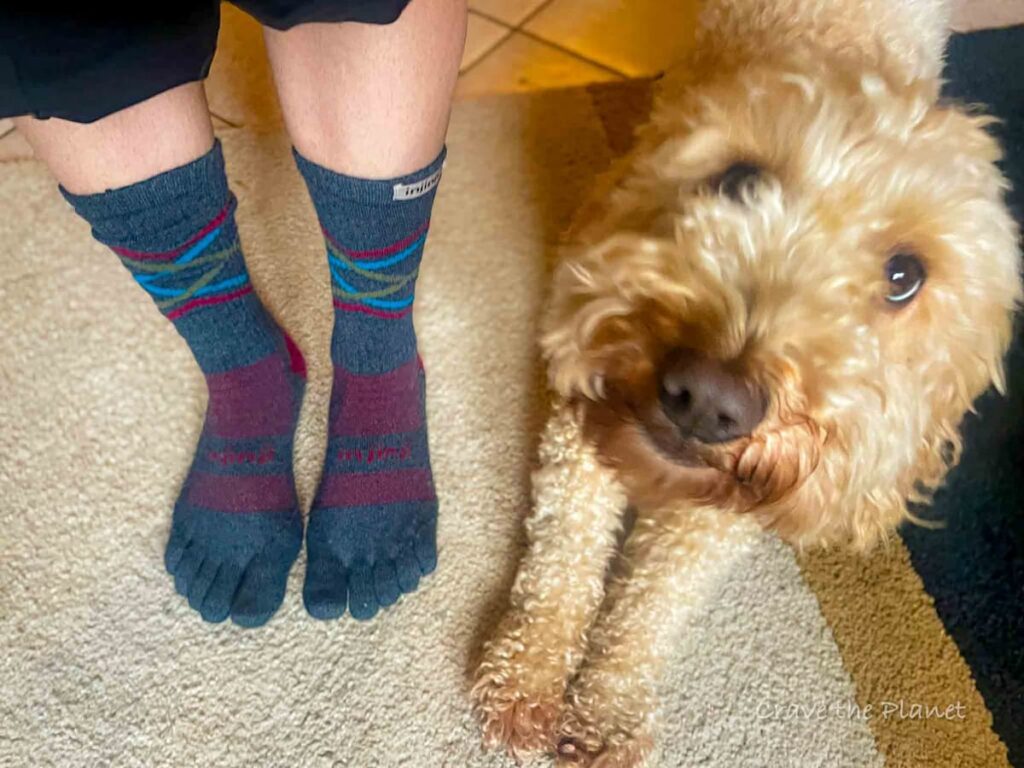
What You Will Learn
- Quick Verdict: Injinji Socks Review
- Morgan’s Injinji Toe Socks Review Video
- Overview: Injinji Socks Review
- Injinji Toe Socks Pros and Cons
- Review: Injinji Socks
- What are Injinji Socks about?
- Is it all Roses and Happy Toes?
- Blister Prevention Youtube from a Physical Therapist
- 10 Tips from a Physical Therapist to Avoid Blisters
- Final Verdict Injinji Socks
- Frequently Asked Questions
- Why Trust?
- More Hiking Resources
Quick Verdict: Injinji Socks Review
Short on time? Don’t have time to read the whole article? No Problemo!
Injinji toes socks can really help those that are especially prone to toe blisters. Once you’ve tried the double sock method and it fails, it’s a good idea to try the injinji toe socks to manage your skin.
You can find them at REI or on Amazon.
Injini Toe Socks Details
Injinji Toe Socks for Hiking
Wondering if Injinji toe socks prevent blisters as claimed? This review tests their performance over years of hiking/running. We analyze the toe design, sizing, breathability, durability and compare to competitors. Find out if the hype is real based on real world testing from avid trail runners and backpackers. The verdict will help you decide if Injinji's innovative socks are worth buying!
For some hikers and runners, Injinji toe socks may provide relief from recurring blisters. Their unique design, which separates each toe, allows feet to move more naturally while preventing friction in vulnerable areas.
This can help reduce blister formation for those with feet that are especially prone.
By keeping skin drier and toes from rubbing together, Injinji socks may allow some to hit the trails with less worry of blisters ruining their hike.
Their construction could mean needing your first aid kit’s blister treatments less often. For the right user, Injinji toe socks may help keep feet happy mile after mile.
Morgan’s Injinji Toe Socks Review Video
Before you invest in Injinji toes socks you should try these cheaper options first:
- basic sock liners
- break in your shoes or boots fully before a big hike
- ensure your boots are 1/2 – 1 size bigger than normal
- keep your feet dry
- experiment with different lacing techniques
But even despite those measures, people like my friend Elena still get awful toe blisters and something like a toe sock can make the difference.
However, no socks will make up for lack of training and time on feet – so while it’s not a magic pill it can really help those suffering from blister pain, especially when hiking downhill.
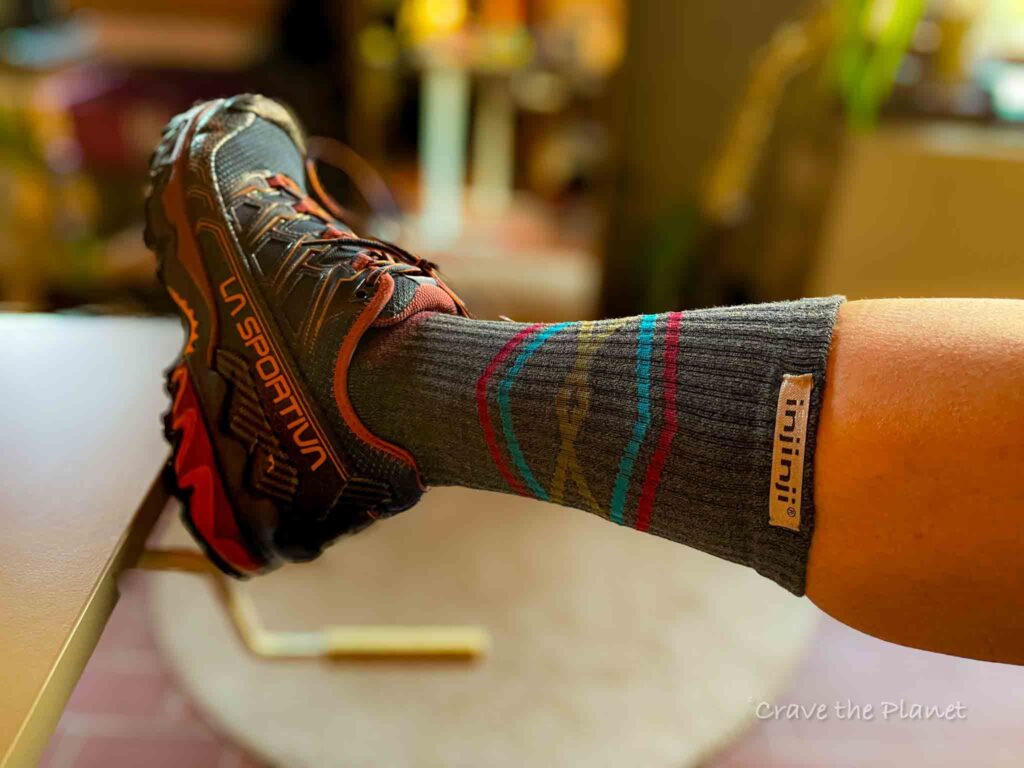
Trust me, socks are an essential item that often gets overlooked but they can make a huge difference in your hiking experience and I know which ones to look for.
Are Injinji Toe Socks for Hiking Worth it?
Not everyone needs toe socks. But they are good for 👎🏻
- 🥾 Mountaineers, Trekkers, Hikers
- 🚴♀️ Multi-sport Athletes
- 🌏 Group Leaders
- 💗 Fitness & Wellness Enthusiasts
This review is targeted at people that want to check out the Injinji toe socks to see if it’s right for them.
Blisters can make hiking uncomfortable and lead to sore calves and even plantar fasciitis from compensation, but they don’t have to ruin the fun. Research has shown that different types of sock structure can change the forces.
🧭 Read until the end for my top travel recommendations for hikers and more advice from a physical therapist hiking & travel addict.
You will also like:
➡️ 🗻 Discover the best 2 way radios for the mountains.
Overview: Injinji Socks Review
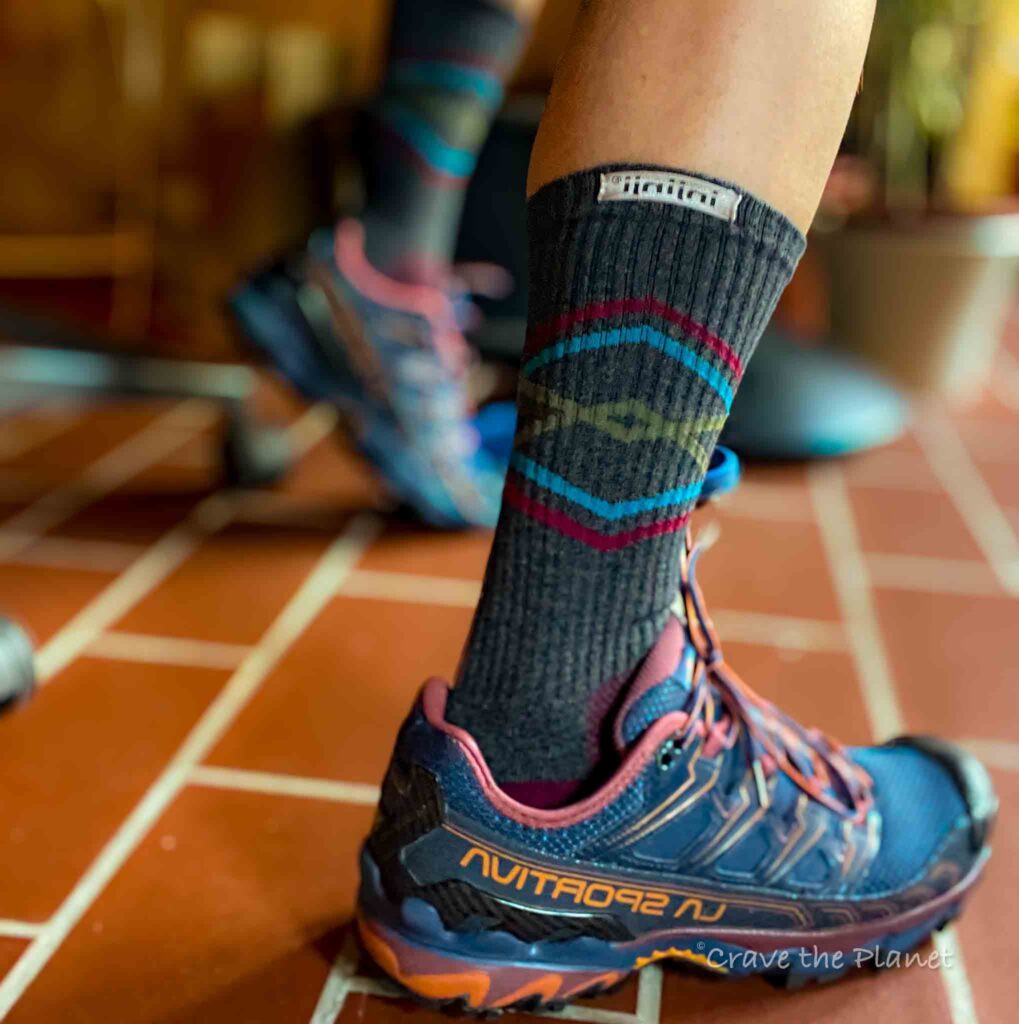
If you’re a hiker, you know that blisters can ruin a trip. Injinji Socks may be the solution to this problem. These socks are designed to fit each toe individually, which can prevent blisters from forming. While they may take a little more effort to put on and take off, the benefits are worth it.
Injinji Socks are made from a variety of materials, including nylon, Lycra, Coolmax, and merino wool. The Coolmax material is sweat-wicking, which means your feet will stay dry and comfortable even on long hikes. The merino wool provides warmth and breathability, making these socks a good choice for cooler weather.
One of the unique features of Injinji Socks is their toe design. Each toe is wrapped in a separate liner, which can help prevent blisters from forming between toes. The socks are also available in a compression style, which can improve circulation and reduce fatigue during long hikes.
While Injinji Socks may not work for everyone, they have received positive reviews from many hikers. The socks are available in a variety of colors and styles, so you can find the perfect pair for your needs.
Injinji Toe Socks Pros and Cons
If you’re considering purchasing Injinji toe socks, it’s important to weigh the pros and cons before making a decision. Here are some potential advantages and disadvantages to keep in mind:
- Reduces friction between your toes
- Moisture-wicking materials
- Improved toe alignment and overall foot health
- Feels weird
- Expensive
- Fills up tight fitting shoes
| Pros | Cons |
|---|---|
| Injinji toe socks can help prevent blisters by reducing friction between your toes. | Some people may find the toe separation uncomfortable or difficult to get used to. |
| The socks are made with moisture-wicking materials to keep your feet dry and comfortable. | Injinji toe socks can be more expensive than traditional socks. |
| The toe separation can help improve toe alignment and overall foot health. | Injinji toe socks may not be suitable for all types of footwear, such as tight-fitting shoes. |
| Injinji toe socks come in a variety of styles and colors to match your personal preferences. | The socks may not provide as much cushioning as some other types of socks. |
Injinji toe socks can be a great choice for those looking to prevent blisters and improve foot health. However, they may not be suitable for everyone and can be more expensive than traditional socks.
Review: Injinji Socks
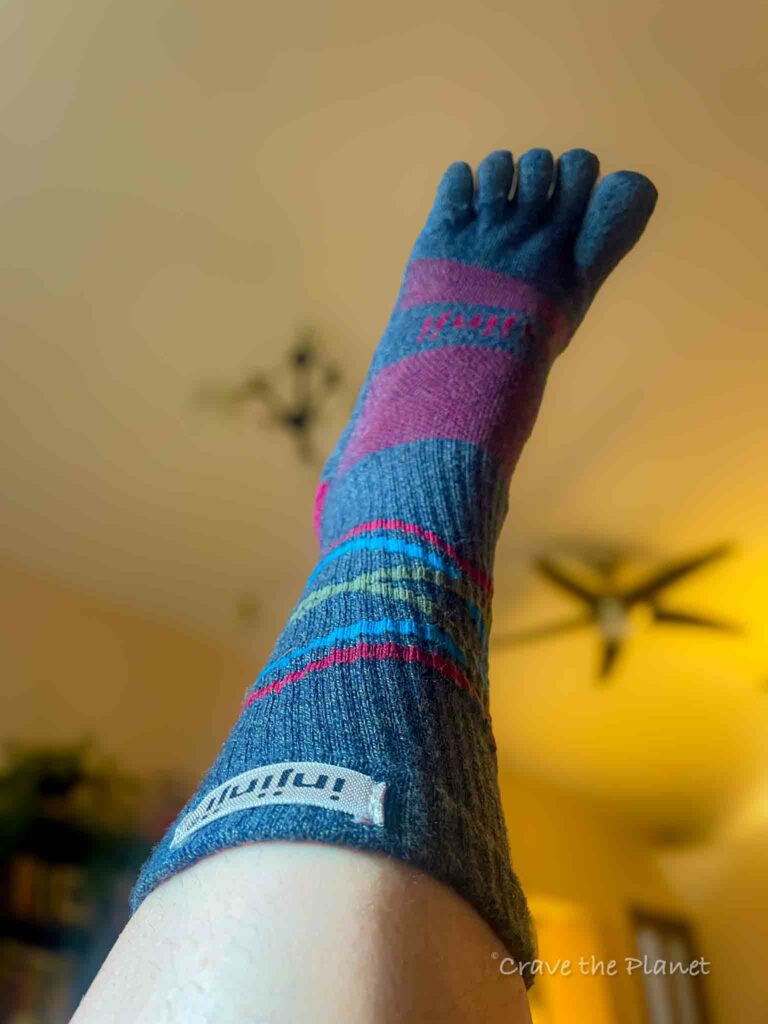
Injinji socks are perfect for those who want to keep their feet comfortable and blister-free during long hikes.
Our testers found that the Injinji Run Lightweight No-Show and Mini-Crew socks provided a perfect fit and true-to-size cushioning. The protective cushioning and versatility of these socks make them a great choice for any outdoor activity.
The material is a blend of CoolMax, Nylon, and Lycra, which ensures durability and comfort.
Want more options? ➡️ Read my roundup of the best toe socks for hiking.
What are Injinji Socks about?
If you’re tired of getting blisters between your toes, Injinji socks may be the solution for you. Injinji socks are designed like gloves for your feet, wrapping each toe individually to eliminate skin-on-skin contact.
This unique five-toe design helps keep your toes cool in the summer, reducing sweat and blisters.
Injinji socks also offer arch support and stability, making them a great option for athletes and anyone looking for more support than traditional socks. The natural foot splay provided by the sock construction helps to improve balance and overall foot health.
Injinji socks come in a variety of colors and are made with environmentally sustainable materials, making them a great choice for those looking for eco-friendly options. With their innovative design and benefits, Injinji socks are a great addition to any sock collection.
Is it all Roses and Happy Toes?
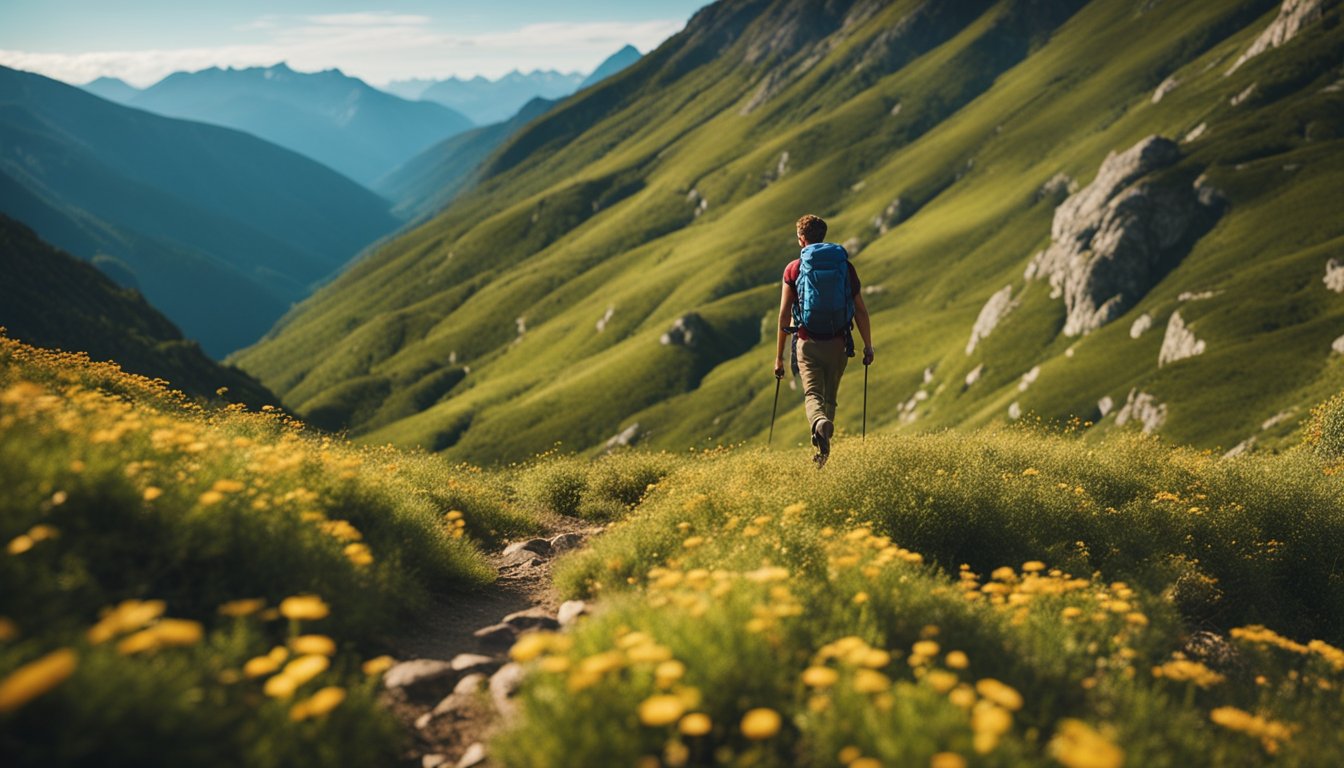
When it comes to Injinji socks, putting them on and taking them off can be a little unusual at first. Unlike traditional socks, you’ll need to feed each toe individually into its own compartment.
When removing the socks, each toe will in turn become inside out, which means you’ll have to push the toes back through before you put them on again. However, this small inconvenience is a small price to pay for comfortable feet, especially when it comes to preventing blisters.
The Injinji Mini Crew and No-Show socks are two of the most popular models. They are essentially the same socks from the ankle down, but the Mini-Crew comes just above the ankle bone, providing a little extra protection for your feet. If you’re wearing sneakers that are a little higher than average, the Mini-Crew is a great choice. However, for most everyday activities, the No-Show is the preferred option.
Blister Prevention Youtube from a Physical Therapist
10 Tips from a Physical Therapist to Avoid Blisters
As a physical therapist with years of experience in hiking, I have found that the following tips can help prevent blisters from forming when hiking.
TIME ON FEET (TOF)
Above all else you have to let your feet adapt to the stress you want to place on them. That means a gradual increase in hiking duration and intensity. Get time on your feet that you can handle and then increase gradually for adaptation.
- Wear properly fitting footwear: Ensure your hiking footwear fits comfortably, with enough room for your toes to move. Tight or loose footwear can cause friction and lead to blisters.
- Break in your new hiking footwear: Before embarking on a long hike, make sure you break in your new shoes or boots by wearing them on shorter walks. This will help your feet get accustomed to the new footwear, preventing blisters from forming.
- Keep your feet dry: Wet feet can increase friction and lead to blisters. Wear moisture-wicking socks and carry an extra pair of socks to change into if your feet get damp.
- Wear moisture-wicking or synthetic socks: Hiking socks made from merino wool are a great option to help keep your feet dry by wicking away moisture, including sweat.
- Apply friction-reducing products before you start hiking: Use an anti-blister balm or cream before you start your hike to help reduce friction on your feet.
- Keep your feet clean: Dirt and debris can cause irritation and lead to blisters. Keep your feet clean and dry throughout your hike.
- Perform Proper Lacing: Snug on uphills and tight on the instep for downhills.
- Take regular breaks: Frequent breaks can help alleviate pressure on your feet and give them a chance to rest and recover. Elevating your feet while enjoying your hiking snack can be helpful.
- Pay attention to hot spots as soon as you feel them: Keep an eye out for any areas on your feet that are beginning to feel tender or irritated. Applying blister-prevention products or taking a break to readjust your footwear can help prevent a blister from forming.
- Double up on your socks: Wearing a thin sock under your main hiking sock can help reduce friction. Ensure that your shoes or boots still fit correctly with the additional thickness.
If you tend to hike through wet and cold places, you may end up requiring more blister care as you’ll likely need neoprene socks for hiking in the extreme cold or perhaps even waterproof hiking socks.
They are great at keeping your feet warm, but the tradeoff is a higher risk for blisters.
Final Verdict Injinji Socks
- Injinji's five-toe patented designed specifically for runners and hikers
- Prevents blisters & hotspots while running
- Ideal use for running, walking and athletic activities
- Superior mositure management during runs of all lengths
- Natural Toe Splay
Frequently Asked Questions
What are the best Injinji socks for ultra running?
Injinji offers a variety of socks that are suitable for ultra running, but the best option will depend on your specific needs. The Injinji Trail series is a popular choice among ultra runners due to their extra cushioning and protection from debris. The Injinji Run series is also a great option for those looking for a lightweight, breathable sock. Ultimately, the best Injinji sock for ultra running will depend on your personal preferences and the conditions of your run.
Do Injinji socks prevent blisters?
Injinji socks are designed with a five-toe sleeve that helps to prevent skin-on-skin friction, which can lead to blisters. The socks also feature a seamless construction that reduces the likelihood of rubbing and irritation. While Injinji socks can be helpful in preventing blisters, they are not a guarantee. Proper shoe fit, foot care, and other factors can also play a role in blister prevention.
How do Injinji liner socks compare to other brands?
Injinji liner socks are designed to be worn as a base layer under other socks. They are made with a lightweight, moisture-wicking fabric that helps to keep feet dry and comfortable. Compared to other liner socks on the market, Injinji liners are known for their durability and ability to stay in place during activity. They also feature the brand’s signature five-toe sleeve, which can help to prevent blisters.
Are Injinji socks good for hiking?
Injinji socks can be a great option for hiking due to their moisture-wicking properties and ability to prevent blisters. The Injinji Trail series, in particular, is designed with extra cushioning and protection from debris, making them a popular choice among hikers. However, the best Injinji sock for hiking will depend on your personal preferences and the conditions of your hike.
Where are Injinji socks manufactured?
Injinji socks are manufactured in various countries, including the United States, China, and South Korea. The specific country of origin will depend on the style and size of the sock.
Can you dry Injinji socks in the dryer?
Injinji recommends air-drying their socks to prolong their lifespan. However, if you must use a dryer, they suggest using a low heat setting and removing the socks promptly after the cycle is complete. High heat can damage the fabric and elastic of the socks, causing them to lose their shape and effectiveness.
Why Trust?
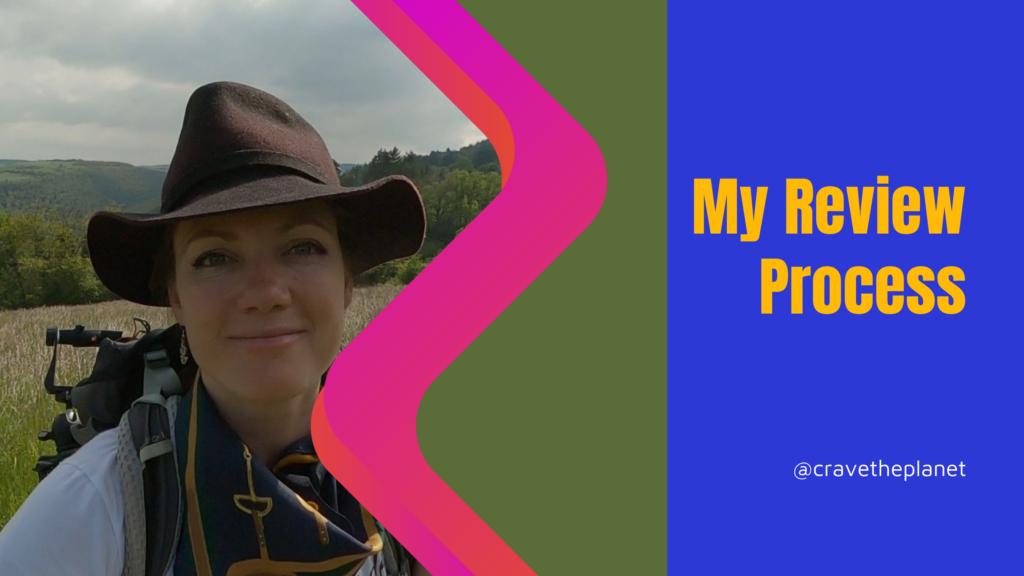
At Crave the Planet, I’m all about honest and relatable reviews of outdoor products. As a physical therapist, hut to hut hiker, downhill skier and mom, I’m constantly trying new gear to make my outdoor experiences more comfy and fun but with science in mind.
I’ll be real with you, I don’t do every outdoor activity. But, who does? I’m just a regular person who loves exploring the planet. Perfectionism is my enemy and I hope to help you ditch that vibe too.
My review process involves testing each product in real-life outdoor situations, but if it’s a really horrible day I’ll probably find a hotel in the valley. I’ll let you know what worked for me and what didn’t, so you can make informed decisions about your gear choices.
I don’t do sponsored reviews or take payment for my reviews. All comments are based on my personal experience. Sometimes I’ll test something and then send it back for a refund. Usually there’s a hefty fee. Bummer. So, if you’re looking for a relatable and honest take on outdoor gear, you’re in the right place.
More Hiking Resources
Here’s more awesome gear to empower your journey.
Physical Therapist Curated Gear Guides for Hikers
- 🧎 Make your knees feel better while hiking and walking: Best Knee Braces for Hiking
- 🌳Make the downhills stop hurting and hike with more confidence Best Trekking Poles Review
- ⌚ Never get lost on the trail and navigate the wilderness safely with My Review of the Best GPS Watches for Hiking
- ❄️ Go hiking in the winter or on icy surfaces safely: The Best Microspikes for Hiking
- 💰 Save money by making your SUV a hotel the night before a big hike: My Review of the BEST Air Mattress for Your SUV
I hope this Injinji socks review helps you gear up for your next adventure.

Author profile: Morgan Fielder is a Doctor of Physical Therapy and passionate hiker who believes in exploring the world on foot with good food. Follow her journey as she shares science-based hiking tips and advocates for sustainable tourism.

